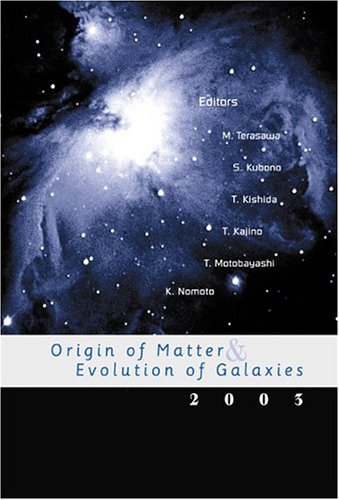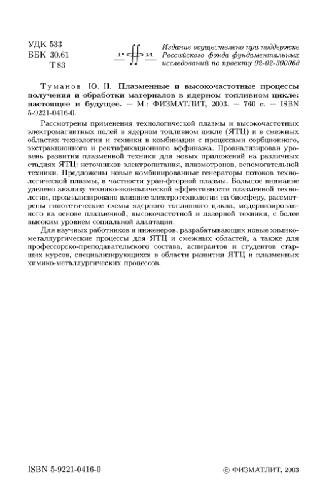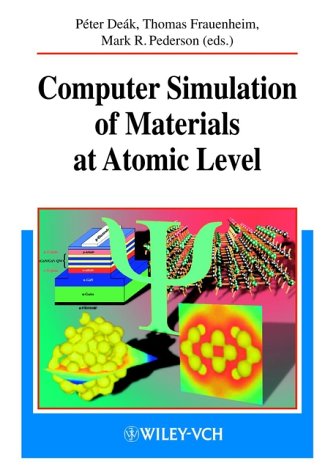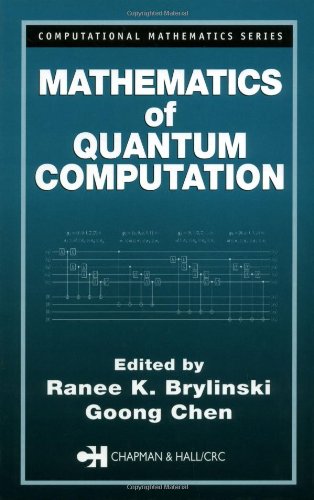M. Terasawa, International Symposium on Origin of Mat, Shigeru Kubono, T. Kishida, Taka Kajino, Tmotobayashi9789812388247, 981-238-824-9
Table of contents :
CONTENTS……Page 10
Preface……Page 8
Review and Scope……Page 18
Origin and Evolution of Matter in Brane-World Cosmology G. J. Muthews……Page 20
1. INTRODUCTION……Page 21
2. Brane-World Cosmology……Page 22
3. Disappearing Dark Matter……Page 23
4. Time Varying vs. Galactic Chemical Evolution……Page 26
5. The Search for a Compact Dimension……Page 30
6. Conclusion……Page 32
References……Page 33
I. Big Bang Cosmology and Primordial Nucleosynthesis……Page 36
Updated Big-Bang Nucleosynthesis Compared to WMAP Results A. COC……Page 38
2. Nuclear reaction rates……Page 39
3. SBBN calculations……Page 41
4.2. Nuclear……Page 45
4.3. Cosrnology……Page 46
4.4. Pregalactic evolution……Page 47
References……Page 48
1. Introduction……Page 50
2. CMB and DCDM……Page 51
2.2. Perturbation Equations……Page 52
2.3. Boltzmann Hierarchy for Daughter Radiation……Page 53
3. CMB Constraint and Discussions……Page 54
References……Page 56
Hadronic Decay of SUSY Particle and Destruction of Light Elements K. Kohri……Page 58
References……Page 60
II. Observations: X-Rays, Cosmic Rays and Meteoritic Anomalies……Page 62
1. Introduction……Page 64
2. INTEGRAL and its Spectrometer……Page 66
3. First Science Results……Page 68
3.1. Interstellar 26Al……Page 69
3.2. Positron Annihilation……Page 71
References……Page 74
1. Introduction……Page 76
2.1. Carbon, N and Si isotopic ratios of SIC grains……Page 78
2.2. AGB star origin of mainstream, Y and Z grains……Page 79
2.4. Z grains……Page 81
3. Models of AGB stars……Page 82
3.1. I . Silicon……Page 83
3.1.2. Titanium……Page 84
References……Page 85
1. Introduction……Page 88
3. Result……Page 89
4. Comparison with stellar metallicity and SN II abundance pattern……Page 91
5. The Fe abundance profile and SN Ia contribution……Page 92
6. The abundance ratios of O,Si and Fe and abundance pattern of SN Ia……Page 94
7. The failure of the cooling flow model……Page 95
References……Page 96
1. Introduction: The Role of Metal-Poor Stars……Page 97
2. Metal-Poor Stars: Searches and Findings……Page 98
2.1. HE 0107–5240: the most metal-poor star ever found……Page 99
2.2. Chemical Signatures of the First Stellar Generations……Page 100
2.3. C-rich, Very Metal-Poor Stars……Page 101
2.4. n-capture Nucleosynthesis in the Early Galaxy……Page 103
2.4.1. Cosmo-chronometry: Dating Very Metal-Poor Stars……Page 105
3. Concluding Remarks……Page 106
References……Page 107
1. Introduction……Page 109
2.1. [X/Fe] us. [Fe/H] predicted by diflerent SN models……Page 110
2.2. Statistical analysis of dispersions and SN yields……Page 112
3.1. Enrichment of Eu in the Halo……Page 113
3.2. Detection of low Eu abundances……Page 115
References……Page 116
III. Weak Interaction, Neutrinos, Dark Matter……Page 118
1. Introduction……Page 120
2. Limits on Solar Density Fluctuations……Page 121
3. Two-Body Axial Current……Page 123
4. Implications for r-process Nucleosynthesis……Page 124
References……Page 125
1. Majorana neutrino masses and double beta decays……Page 128
2. Effective neutrino mass and neutrino mass spectrum……Page 129
3. Sensitivity of Experiments to the effective neutrino mass……Page 131
4. Rare nuclear decay measurements with signal selection by spatial and time correlation analyses……Page 133
5.1. MAJORANA for double beta decays of 76Ge……Page 134
5.2. MOON for double beta decays of 100Mo……Page 135
5.3. CUORE for double beta decays of 130Te……Page 136
6. Summary and remarks……Page 137
References……Page 138
1. Introduction……Page 140
2.1. Experimental set-up……Page 142
2.2. Measurement and Result……Page 143
3.1. Measurement of anisotropic scintillation response……Page 146
3.2. Kamioka pilot experiment……Page 147
4. Summary……Page 148
References……Page 149
1. Introduction……Page 150
2.1. Nebular Flow……Page 151
2.2. Emissivity of High Eneqy Gamma-rays and Neutrinos……Page 152
4. Conclusion……Page 153
References……Page 154
IV. Evolution and Nucleosynthesis in Stars, and Cross Sections — Hydro Static Burning……Page 158
1. Introduction……Page 160
2. Introduction to ANCs……Page 161
3. Recent ANC Measurements……Page 163
4. S factors from the ANCs and their astrophysical importance……Page 166
References……Page 171
1. Introduction……Page 172
2. Characteristics of Coulomb Dissociation of Halo Nuclei and Neutron Capture Reaction……Page 173
3. Experimental Procedure……Page 175
4. Results and Discussions……Page 176
5 . Summary……Page 177
Acknowledgement……Page 178
References……Page 179
1. Introduction……Page 180
2.1. Trends in the iron peak elements and hypernovae……Page 181
3. EMP Stars with Typical (C-normal) Abundance Pattern……Page 185
4.1. The most Fe-poor star: HE 0107-5240……Page 188
References……Page 190
1. Introduction……Page 192
2.1. Models and Assumptions……Page 193
2.2. Presupernova Evolution……Page 194
3.1. Hydrodynamics……Page 195
3.3. Treatment of Jet Matter……Page 196
5. Explosive Nucleosynthesis……Page 197
6. Integrated Abundance Patterns and Comparison with Observation……Page 199
7. Conclusions……Page 200
References……Page 201
1. INTRODUCTION……Page 202
2.1. Quasi-Free mechanism……Page 204
2.2. From Quasi Free Reactions to the Trojan Horse Method……Page 205
3. VALIDITY TEST FOR THE POLE APPROXIMATION……Page 207
4. RESULTS……Page 208
References……Page 212
1. Introduction……Page 214
2 . The Models……Page 216
3.1. 22Ne(n)25Mg reaction and the s-process……Page 217
3.2. The s-Process in Extremely Low Metdlicity Stars……Page 220
References……Page 222
186Re Isomer Contribution to 187Re-187Os Cosmochronometer T. Hayakawa……Page 225
1. Introduction……Page 226
2. Measurement of the neutron capture ratio of the isomer to the ground state in 186Re……Page 227
3. Estimation using the steady-flow model……Page 231
References……Page 232
1. Introduction……Page 234
2. Experimental Method……Page 235
3. Data Analysis……Page 236
4. Target Monitor……Page 238
5. Result……Page 240
6. Summary and Discussion……Page 241
References……Page 242
V. Nuclear Data and Nuclear Physics……Page 244
1. Introduction……Page 246
3. Towards the Universal Nuclear Energy Density Functional……Page 247
3.1. Density Functional Theory and Skyrme HFB……Page 249
3.2. From Finite Nuclei to Bulk Nucleonic Matter……Page 250
3.3. Microscopic Mass Table……Page 251
4.1. Gamow Shell Model……Page 253
5. Conclusions……Page 254
Acknowledgments……Page 255
References……Page 256
1. Introduction……Page 258
2.2. The R-matrix method……Page 259
2.3. The DWBA method……Page 262
2.4. Microscopic models……Page 265
3. Conclusion……Page 268
References……Page 269
1. Introduction……Page 271
2. Fission-Barrier Studies……Page 272
2.2. Global Barrier Studies……Page 273
2.3. Barriers of r-Process Nuclei……Page 276
3. Decay Properties……Page 277
4. Summary and Conclusions……Page 281
References……Page 282
Synthesis of Superheavy Elements K. Morita……Page 283
References……Page 284
1. Introduction……Page 285
2. The Asymptotic Normalization Coefficient method……Page 286
3. The method of Continuum-Discretized Coupled-C hannels……Page 287
4. Numerical results and the extracted S17(0)……Page 289
References……Page 291
VI. Novae, Supernovae, and Explosive Nucleosynthesis, GRB Models and Nuclearphysics Parameters……Page 294
1. Introduction……Page 296
2. Prompt Explosion……Page 298
3. The r-Process……Page 302
4. Contribution to Chemical Evolution of the Galaxy……Page 304
5. Summary……Page 305
References……Page 306
Nucleosynthesis in the Neutrino-Driven Winds from Rotating Proto-Neutron Stars T. Yamasaki……Page 308
References……Page 309
1. Introduction……Page 310
2.2. Neutrino-Nucleus Reactions and Network Calculations……Page 312
3.1. Effects of Neutral-Current Interactions……Page 313
3.2. Effects of Charged-Current Interactions……Page 314
4. Summary……Page 318
References……Page 319
1. Introduction……Page 321
2. RIKEN RI Beam Factory (RIBF)……Page 322
3. Half-life measurement……Page 325
4. Design and construction of beta counting system……Page 326
4.2. Beta-my detection system……Page 327
4.3. Half-life measurement at RIPS……Page 328
4.4. Future upgrade of beta counting system……Page 331
References……Page 332
Direct Measurements of the Astrophysical (n) and (p, n) Reactions by Using Low-Energy Light Neutron-Rich RNB H. Ishiyama……Page 333
2.1. RNB production……Page 334
2.2. Detector system……Page 336
2.3. Measurements……Page 338
3. Results……Page 339
4. Summary……Page 341
References……Page 342
1. Introduction……Page 343
2. C+O star models for SNe Ic……Page 344
3. Spectrum Synthesis……Page 346
4. Light Curve Construction……Page 347
5 . Light Curve Fitting……Page 348
6. Discussion……Page 349
References……Page 350
The “Dark Side” of Gamma-Ray Bursts and Implications for Nucleosynthesis of Light and Heavy Elements S. Inoue……Page 353
2. Evidence for BROs: the “Dark Side” of GRBs……Page 354
3. Nucleosynthesis in GRB-BROs……Page 355
4. Observational Implications……Page 358
References……Page 359
1. Introduction……Page 361
3. Abundance Distribution inside Disks……Page 362
4.1. 56Ni in Winds……Page 364
4.2. Chemical Composition of Winds……Page 367
4.3. Chemical Composition of Winds from Neutron-rich Regions of Disks……Page 368
5. Summary……Page 369
References……Page 370
Direct Measurement of the Astrophysical Reaction 14O(p)17F M. Notani……Page 371
1. Introduction……Page 372
2. Experimental Setup……Page 373
3. Result and Discussion……Page 375
4. Summary……Page 376
References……Page 377
Elastic Resonance Scattering of 23Mg+p T. Teranishi……Page 378
2. Experiment……Page 379
3. Results……Page 381
4. Summary……Page 382
References……Page 383
1. Introduction……Page 384
2. Experiment……Page 385
3. Data Analysis……Page 386
4. Excitation energies in 22Mg……Page 388
6. Summary and Conclusion……Page 389
References……Page 391
The 21Na(p, ) 22Mg Reaction from Ecm = 200 to 850 KeV in Explosive Stellar Events S. Bishop……Page 392
1. Introduction……Page 393
3. Experimental Facilities……Page 395
4.2. 329 lceV Resonance……Page 397
4.4. 538 and 740 keV Resonances……Page 398
References……Page 400
VII. Nuclear Equation of State and Neutron Stars……Page 402
1. Introduction……Page 404
2.1. QHD……Page 406
2.3. MQMC……Page 407
2.5. MQMC-MB……Page 409
3.1. EoS……Page 410
4. Conclusion……Page 412
References……Page 413
1. Introduction……Page 414
2. Bulk calculations and finite-size effects……Page 415
3.1. Thermodynamic potential for hadron – quark deconfinement transition……Page 417
3.2. Gauge invariance……Page 419
3.3. Results……Page 420
4. Summary and Concluding remarks……Page 422
References……Page 423
1. Introduction……Page 424
2. Macroscopic nuclear model……Page 425
3. Optimal relations among EOS parameters……Page 427
4. Neutron rich nuclei in laboratories……Page 430
6. Summary……Page 431
References……Page 433
1. Introduction……Page 434
2. Density Functional Theory with the Relativistic Mean-field Model……Page 435
3. Bulk Property of Finite Nuclei……Page 437
4. Nuclear “Pasta” at Sub-nuclear Densities……Page 438
4.1. Symmetric Nuclear Matter and the Coulomb Screening Eflect……Page 439
4.2. Nuclear Matter in Beta Equilibrium……Page 441
References……Page 442
VIII. Stellar Abundance, Galactic Chemical Evolution and Nucleo-Cosmochronology……Page 444
1. Measurements of isotope abundances in stellar photospheres……Page 446
2.1. Eu isotopes produced by r-process……Page 448
2.2. Eu isotopes produced by s-process: a new probe of 151Sm branching……Page 450
3. Li isotopes……Page 454
References……Page 455
1. Introduction……Page 457
2. Observations……Page 458
3. Results and Discussion……Page 459
References……Page 462
1. Introduction……Page 463
2. Equations……Page 464
4. The Energy Distributions……Page 466
5.1. Transfer Equation……Page 467
5.2. Yields of Light Elements……Page 470
References……Page 472
Supernova Neutrinos and Their Influence on Nucleosynthesis: Light Elements and r-Process Elements T. Yoshida……Page 473
2. Calculations……Page 474
3.1. The Ejected Masses of 7Li and 11B……Page 476
3.2. The r-Process Abundance Pattern……Page 478
4. Discussion on the Galactic Chemical Evolution……Page 480
5. Summary……Page 481
References……Page 482
1. Introduction……Page 483
2. Mg isotope ratio in NGC 6752……Page 484
3.1. A model for globular cluster formation……Page 485
3.2. Our calculation……Page 486
3.3. Results……Page 487
4. Neutron capture elements in globular clusters……Page 489
References……Page 490
Poster Session……Page 492
1. Introduction……Page 494
2. Experiment……Page 495
3. Results……Page 496
References……Page 497
1. Introduction……Page 498
2. Experimental procedure……Page 499
3. Experimental results……Page 500
References……Page 501
1. Introduction……Page 502
3. Measurements and Analyses……Page 503
References……Page 505
Supernova Explosion Energy with Relativistic EoS Including Hyperon C. Ishizuka……Page 506
2. Construction of relativistic EOS table with hyperons……Page 507
3. Application to Hydro-dynarnical calculation……Page 508
References……Page 509
1. Introduction……Page 510
2. Results……Page 511
References……Page 513
1. Comparison of the Temperature……Page 514
3. Comparison of the Expansion Velocity……Page 515
4. Comparison of the Matter Density……Page 516
References……Page 517
1. Introduction……Page 518
2. Kaon Condensation in High-density Matter……Page 519
References……Page 521
Study of Proton Resonances in 26Si and 27P by the Elastic Scattering of 1H(25Al, p) 25Al, 1H(26Si, p)26Si J. Y. Moon……Page 522
2. Experimental procedure……Page 523
3. Preliminary results……Page 524
References……Page 525
1. Introduction……Page 526
3. Time evolution of dust-to-gas mass ratio and metallicity……Page 527
References……Page 529
1. Introduction……Page 530
3. Analysis and conclusions……Page 531
References……Page 533
Quantitative Estimate of the Reaction Dependence of the r-Process Nucleosynthesis T. Sasaqui……Page 534
2.1. Definition of Reaction Sensitivity……Page 535
2.2. Hydrodynamics……Page 536
References……Page 537
1. Introduction……Page 538
2.2.1 Cross section measurement of (n,y) reactions on Os isotopes……Page 540
References……Page 541
1. Nuclear Data Evaluations for Stellar Explosion Studies……Page 542
2. Strategies for Future Nuclear Astrophysics Data Activities……Page 543
References……Page 545
Nucleosynthesis in Extremely Metal Poor Stars and the Origin of the Most Metal-Poor Star HE0107-5240 T. Suda……Page 546
References……Page 549
I . Introduction……Page 550
3. The 11B,11 LQ reaction……Page 551
5. 56Fe(11B,11Li) reaction……Page 552
References……Page 553
1. Introduction……Page 554
2. p-TPC: advanced gaseous tracking device……Page 555
4. Conclusion……Page 556
References……Page 557
1. Introduction……Page 558
3. Results……Page 559
References……Page 561
2. Results……Page 562
3. Summary……Page 563
References……Page 564
1. Introduction……Page 566
2. Experimental Setup……Page 567
3. Results and Discussions……Page 568
References……Page 569
The Trojan Horse Method Applied to the Astrophysically Relevant Proton Capture Reactions on Li Isotopes A. Turmino……Page 570
2. Experimental details and results……Page 571
References……Page 573
1. Equation of state and pressure for neutron matter……Page 574
References……Page 577
1. Introduction……Page 578
3. Data of Presolar Grains from Supernovae……Page 579
4. Results and Discussion……Page 580
References……Page 581
Symposium Program……Page 582
List of Participants……Page 590
Author Index……Page 602







Reviews
There are no reviews yet.